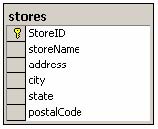Updating
Viewing
Deleting
Inserting
Truncating
第1题:
You are the administrator of a SQL Server 2000 computer. You are creating a data transformation services package. As the first step in this process, you need to load data from text files into a database table. These text files contain data on new stores that join your franchise. The text files list the data columns in the following format StoreID, StoreName, Address, City, State, PostalCode, ManagerID, StoreTypeID, FacilityID.
The destination table is configured as shown in the exhibit.

You want to load the data into the table as quickly as possible. What should you do?
A.Use a Bulk Insert Task to read the data into a temporary table. Use an Execute SQL task to import the appropriate data into the destination table.
B.Create and edit a format file to select the columns you want to import. Use a Bulk Insert Task, and then specify the format file to import the appropriate data into the destination table.
C.Use a transform. data task to import the data. Use Microsoft ActiveX transformation scripts to write the appropriate data to the appropriate columns in the destination table.
D.Create and edit a format file to select the columns you want to import. Use a transform. data task, and then specify the format file to import the appropriate data into the destination table.
第2题:
Given the following function:CREATE FUNCTION emplist () RETURNS TABLE ( id CHAR(6) , firstname VARCHAR(12) , lastname VARCHAR(15) ) LANGUAGE SQL BEGIN ATOMIC RETURN SELECT EMPNO, FIRSTNME, LASTNAME FROM EMPLOYEE WHERE WORKDEPT IN (‘A00‘, ‘B00‘); ENDHow can this function be used in an SQL statement?
A.SELECT TABLE(EMPLIST()) FROM EMPLOYEE
B.SELECT TABLE(EMPLIST()) AS t FROM EMPLOYEE
C.SELECT EMPLIST(id, firstname, lastname) FROM EMPLOYEE
D.SELECT id, firstname, lastname FROM TABLE(EMPLIST()) AS t
第3题:
In a test database, you issue the SELECT … INTO OUTFILE statement to create a file with your t1 table data. You then TRUNCATE this table to empty it.()Mysql> SELECT * INTO OUTFILE ‘/tmp/t1.sql‘ from t1;mysql> TRUNCATE t1;
A.$ mysqladmin – u root – p – h localhost test – restore /tmp/t1.sql
B.Mysql> INSERT INTO t1 VALUES FROM ‘/tmp/t1.sql‘
C.$ mysql – u root – p – h localhost test < /tmp/t1.sql
D.Mysql> LOAD DATA INFILE ‘/tmp/t1.sql‘ INTO TABLE t1
E.$ mysqlinport – u root – p – h localhost test /tmp/t1.sql
第4题:
Given the following function: CREATE FUNCTION emplist ( ) RETURNS TABLE ( id CHAR(6) , firstname VARCHAR(12) , lastname VARCHAR(15) ) LANGUAGE SQL BEGIN ATOMIC RETURN SELECT EMPNO, FIRSTNME, LASTNAME FROM EMPLOYEE WHERE WORKDEPT IN ('A00', 'B00'); END How can this function be used in an SQL statement?
第5题:
You are creating the DEPT_SAL data block from the PAYHIST form. Users should be able to enter a valid department ID number, which will then display the employee salary information for that department. This data block could potentially retrieve a large number of records. Since users will probably only view a small number of these records, only 10 records should be fetched at one time. How would you create the data block?()
第6题:
You are the administrator of a SQL Server 2000 computer in your company's personnel department. Employee data is stored in a SQL Server 2000 database. A portion of the database schema is shown in the exhibit.

You want to create a text file that lists these data columns in the following format title, FirstName, LastName, WorkPhone, PositionName, DepartmentName.
You want to create the text file as quickly as possible. You do not expect to re-create this file, and you want to avoid creating new database objects if possible.
What should you do?
A.Use the bcp utility to export data from each table to a separate text file. Use format files to select the appropriate columns. Merge the data from each text file into a single text file.
B.Create a view that joins data from all three tables include only the columns you want to appear in the text file. Use the bcp utility to export data from the view.
C.Create a SELECT query that joins the data from the appropriate columns in the three tables. Add an INTO clause to the query to create a local temporary table. Use the bcp utility to export data from the local temporary table to a text file.
D.Create a SELECT query that joins the data from the appropriate columns in the three tables. Add an INTO clause to the query to create a global temporary table. Use the bcp utility to export data from the global temporary table to a text file.
第7题:
In a test database, you issue the SELECT … INTO OUTFILE statement to create a file with your t1 table data. You then TRUNCATE this table to empty it.() Mysql> SELECT * INTO OUTFILE '/tmp/t1.sql' from t1; mysql> TRUNCATE t1;
第8题:

A. Updating
B. Viewing
C. Deleting
D. Inserting
E. Truncating
第9题:
You are using flat files as the data source for one of your data warehousing applications. To optimize the application performance, you plan to move the data from the flat files to clustered tables in an Oracle database.While migrating the data, you want to have minimal impact on the database performance and optimize the dataload operation. Which method would you use to load data into the Oracle database()
第10题:
Which SELECT statement should you use to extract the year from the system date and display it in the format "1998"?()